neozone
On this page, you find all documents, package deals, and flashcards offered by seller maogarden.
- 14
- 0
- 0
Community
- Followers
- Following
14 items
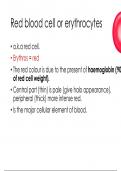
Red cell physiology notes
1. In macrophages, the globin part of Hb is broken down to individual amino acids (red arrow) and metabolized or used to build new proteins. 2. The heme of Hb releases iron. The heme is converted into bilirubin. 3. Blood transports iron to the red bone marrow, where it is used to produce new Hb (green arrows). 4. Blood transport bilirubin (blue arrows) to the liver. 5. Bilirubin is excreted as part of the bile into the small intestine. Some bilirubin derivatives contribute to the color of fa...
- Class notes
- • 64 pages •
1. In macrophages, the globin part of Hb is broken down to individual amino acids (red arrow) and metabolized or used to build new proteins. 2. The heme of Hb releases iron. The heme is converted into bilirubin. 3. Blood transports iron to the red bone marrow, where it is used to produce new Hb (green arrows). 4. Blood transport bilirubin (blue arrows) to the liver. 5. Bilirubin is excreted as part of the bile into the small intestine. Some bilirubin derivatives contribute to the color of fa...
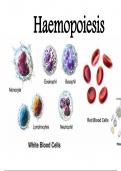
(PHYSIOLOGY) haemopoiesis
Haemopoiesis/Haematopoiesis occurs in the bone marrow from haematopoietic stem cell. Erythropoiesis Process of production of red cell Red cell’s lifespan is about 120 days Bone marrow replaces the cell lost by senescence, haemorrhage or destruction Red cell mass in normal man (26 – 29 mL/kg of body weight) maintained and regulated by the bone marrow
- Class notes
- • 33 pages •
Haemopoiesis/Haematopoiesis occurs in the bone marrow from haematopoietic stem cell. Erythropoiesis Process of production of red cell Red cell’s lifespan is about 120 days Bone marrow replaces the cell lost by senescence, haemorrhage or destruction Red cell mass in normal man (26 – 29 mL/kg of body weight) maintained and regulated by the bone marrow
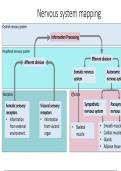
(PHYSIOLOGY) Autonomic Nervous System
Auto “self” and nomos “control”. The responses of the body to the environment without conscious control of the individual. Carried out by the autonomic part of the nervous system.
- Class notes
- • 82 pages •
Auto “self” and nomos “control”. The responses of the body to the environment without conscious control of the individual. Carried out by the autonomic part of the nervous system.
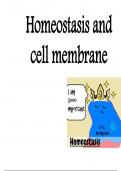
(PHYSIOLOGY) Homeostasis and cell membrane
Refers to the maintenance of constant internal the environment of the body. internal environment to the body = extracellular fluid (ECF) in which the cells live.
- Class notes
- • 56 pages •
Refers to the maintenance of constant internal the environment of the body. internal environment to the body = extracellular fluid (ECF) in which the cells live.
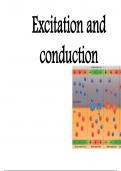
(PHYSIOLOGY) Excitation and conduction
Electrical potential difference exists across the membrane of the cell with the inside being negative in relation to the outside.
- Class notes
- • 31 pages •
Electrical potential difference exists across the membrane of the cell with the inside being negative in relation to the outside.
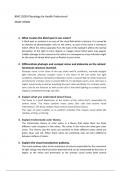
Physiology (vision)
The trichromatic theory of color vision is a theory that states there are three different color receptors in the retina. The cones in the retina are what give color vision. This theory says the cones are sensitive to three different colors which are green, blue, and red. When these colors are combined, eyes can tell a difference between millions of colors.
- Class notes
- • 2 pages •
The trichromatic theory of color vision is a theory that states there are three different color receptors in the retina. The cones in the retina are what give color vision. This theory says the cones are sensitive to three different colors which are green, blue, and red. When these colors are combined, eyes can tell a difference between millions of colors.

Biochemistry Lab Report (Urinalysis)
Pigments and other compounds in certain foods and medications can change the urine color. Beets, berries and fava beans are among the foods most likely to affect the color. Many over-the-counter and prescription medications give urine vivid tones, such as red, yellow or greenish blue.
- Class notes
- • 10 pages •
Pigments and other compounds in certain foods and medications can change the urine color. Beets, berries and fava beans are among the foods most likely to affect the color. Many over-the-counter and prescription medications give urine vivid tones, such as red, yellow or greenish blue.
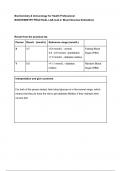
BIOCHEMISTRY PRACTICAL LAB ( Blood Glucose Estimation)
determine the level of blood glucose using the glucose oxidase method
- Class notes
- • 5 pages •
determine the level of blood glucose using the glucose oxidase method
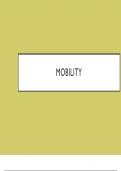
Principle of Body Mechanic
Nurses should integrate principles of body mechanics when performing nursing activities to care for patients effectively and safely as well as reduce the risk of occupational injuries.
- Class notes
- • 30 pages •
Nurses should integrate principles of body mechanics when performing nursing activities to care for patients effectively and safely as well as reduce the risk of occupational injuries.
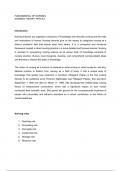
NURSING THEORY(PEPLAU)
Following Hildegard Peplau's view, nursing is an interpersonal process of therapeutic interactions between a patient who is ill or in need of medical attention and a nurse specially trained to recognize and respond to the need for assistance.
- Class notes
- • 7 pages •
Following Hildegard Peplau's view, nursing is an interpersonal process of therapeutic interactions between a patient who is ill or in need of medical attention and a nurse specially trained to recognize and respond to the need for assistance.
